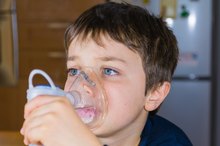What is DOE in Medical Terms?
Dyspnea is the medical term for shortness of breath. The term DOE stands for dyspnea on exertion. Understanding the cause of DOE is key to treating the condition and improving quality of life. Often DOE presents itself in the process of an active disease. It is reported that 75 percent of dying patients suffer from some form of dyspnea, and 27 percent of people suffer with DOE in their daily lives. The severity of DOE is variable with each case and comes from a variety of causes. If any changes in normal breathing patterns occur, medical advice should be sought, and 911 should be called immediately when chest pain accompanies acute shortness of breath.
If you are experiencing serious medical symptoms, seek emergency treatment immediately.
Causes
Having DOE is a symptom rather than a disease in itself. A person who suffers with DOE might find that ordinary efforts like walking, getting out of bed or even coughing can cause shortness of breath. The two primary types of conditions that contribute to DOE are cardiac disease and pulmonary disease. Other causes of DOE are linked to vascular problems, infection, obesity, deconditioning (complete lack of physical exercise) and neuromuscular issues.
- Having DOE is a symptom rather than a disease in itself.
- The two primary types of conditions that contribute to DOE are cardiac disease and pulmonary disease.
Cardiac DOE
Shortness of Breath During Weight Loss
Learn More
One of the main causes of DOE is cardiac disease. When a cardiac source is identified and the problem is chronic, it can usually be traced to left ventricular (LV) heart failure. Coronary artery disease (CAD), congestive heart failure (CHF), atrial fibrillation (a-fib) or a heart attack (MI) can all lead to sudden DOE. If breathing becomes more difficult when the subject lies down and breaths are shallow, but not rapid, then suspect a cardiac origin. Sufferers of this type of dyspnea will usually sleep with pillows propping them up. Paroxysmal nocturnal dyspnea is a condition born of LV heart failure. Shortness of breath begins a couple of hours into the sleep cycle. Symptoms include perspiration, coughing and wheezing.
- One of the main causes of DOE is cardiac disease.
- When a cardiac source is identified and the problem is chronic, it can usually be traced to left ventricular (LV) heart failure.
Pulmonary DOE
Of all pulmonary causes of DOE, COPD (chronic obstructive pulmonary disease) is the most common. The typical COPD patient exacerbates breathing problems by the anxiety of breathlessness. During an acute attack, the breathing pattern in these patients is described by most as a tightness in the chest with the accompanying feeling of forced breathing. These symptoms worsen with mild exercise 1. In pulmonary edema, patients often describe a feeling of suffocating, also known as "air hunger." Air hunger is a much more pervasive condition than simple DOE. Other pulmonary causes for DOE are a pulmonary embolus (moving clot), pneumothorax (air pocket outside of the designated lung tissue), fibrotic disease or a chest infection.
- Of all pulmonary causes of DOE, COPD (chronic obstructive pulmonary disease) is the most common.
- The typical COPD patient exacerbates breathing problems by the anxiety of breathlessness.
Effects
Differences Between Asthma and Bronchitis
Learn More
The effects upon those who live with chronic DOE vary. Some patients have to have ready access to oxygen at all times while others must carry inhalers to offset any sudden attacks of dyspnea with or without exertion. Lifestyle changes are frequent, as the sufferer must plan daily activities carefully. Some degree of social isolation is not uncommon. Another effect is the panic state that many people enter when they feel that they can't catch their breath and the continuous fear of falling into that panic state.
- The effects upon those who live with chronic DOE vary.
- Lifestyle changes are frequent, as the sufferer must plan daily activities carefully.
Treatment
The first step toward the treatment of DOE is a thorough medical history and physical. Because DOE is a symptom, the medical provider must look for the underlying problem. In the diagnostic phase of treatment, the patient might undergo X-rays, scans and other tests. Once the cause of the DOE is determined, appropriate management can begin. If the dyspnea is manifested by lung disease, bronchodilators (medications that open the bronchial tubes in the lungs) are usually effective. Opioids are even more effective in reducing shortness of breath and the work of breathing by desensitizing the body's response to increased carbon dioxide levels. Finally, anti-anxiety medications such as:
- Xanax
- Valium
- or Ativan can reduce fear
- panic
- but also have a direct influence on breathing rates
A medical professional might prescribe one or a combination of treatments to control DOE. Non-pharmocological methods of treatment include posture and positioning, use of fans, and supervised exercise programs.
- The first step toward the treatment of DOE is a thorough medical history and physical.
- If the dyspnea is manifested by lung disease, bronchodilators (medications that open the bronchial tubes in the lungs) are usually effective.
Related Articles
References
- American Family Physician
- Berliner D, Schneider N, Welte T, Bauersachs J. The Differential Diagnosis of Dyspnea. Dtsch Arztebl Int. 2016;113(49):834–845. doi:10.3238/arztebl.2016.0834
- Williams N. The MRC breathlessness scale. Occup Med (Lond). 2017;67(6):496-497.doi:10.1093/occmed/kqx086
- Esteban C, Quintana JM, Moraza J, et al. BODE-Index vs HADO-score in chronic obstructive pulmonary disease: Which one to use in general practice?. BMC Med. 2010;8:28.doi:10.1186/1741-7015-8-28
- Wahls SA. Causes and evaluation of chronic dyspnea. Am Fam Physician. 2012;86(2):173-82.
- Nishino T. Dyspnoea: underlying mechanisms and treatment. Br J Anaesth. 2011;106(4):463-74. doi:10.1093/bja/aer040
- American College of Chest Physicians. Shortness of Breath. Updated January 2018
- Janssens T, Van de moortel Z, Geidl W, et al. Impact of Disease-Specific Fears on Pulmonary Rehabilitation Trajectories in Patients with COPD. J Clin Med. 2019;8(9).doi:10.3390/jcm8091460
- Donald A. Mahler; Denis E. O'Donnell (20 January 2014). Dyspnea: Mechanisms, Measurement, and Management, Third Edition. CRC Press.
- Wills CP, Young M, White DW (February 2010). "Pitfalls in the evaluation of shortness of breath". Emerg. Med. Clin. North Am.
Writer Bio
Judy Collins is the author of a host of articles pertaining to health, fitness and green consciousness-raising. As a registered nurse with more than 17 years experience, she offers the benefit of her experience in healthcare and wise choices for healthy living.







